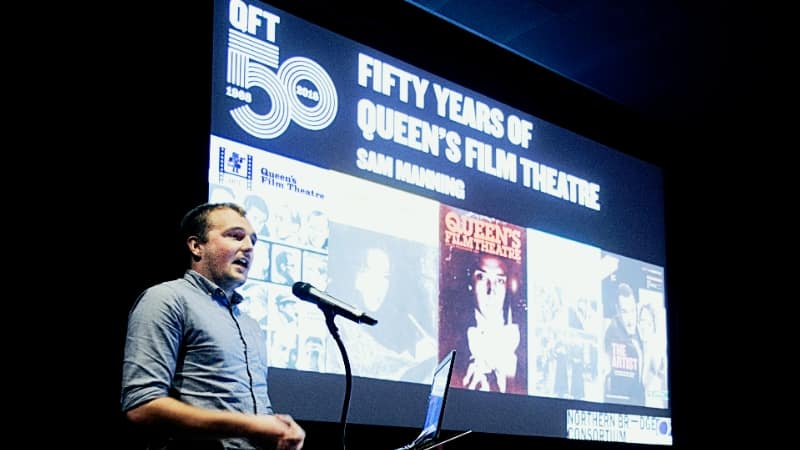Remembering QFT: Impact of Cultural Cinema
By Dr. Sam Manning
30 October 2018
Dr. Sam Manning, film scholar, looks back at the cultural significance of QFT

Dr. Sam Manning, film scholar
At the beginning of this year, I received a grant to explore Northern Ireland’s cinema history and heritage, working in partnership with Queen’s University Belfast and Film Hub NI. The fact that QFT was due to celebrate its fiftieth anniversary in October provided the perfect opportunity to research its history and to engage public audiences with the material I uncovered.
My first step was to scour the archives of places such as the British Film Institute, the Public Record Office of Northern Ireland and the McClay Library’s Special Collections. Newspaper articles, cinema programmes and correspondence all provided a wealth of information on the cinema’s operations, finances and programming. As a historian, I’m used to spending hours in dusty archives sifting through yellowing papers. Thankfully, there was an abundance of QFT material to keep me busy.
Though fascinating, this archival research did little to capture the impact of cinema on people’s lives and the personal experiences of those who ran, visited and worked in QFT. I wanted to speak to these people about their experiences and to understand what the cinema meant to them. During my PhD research on the history of post-war cinema-going I recorded oral history interviews with Belfast cinema-goers. Given the importance of public engagement to the current project, it made sense to document and preserve the memories of QFT’s current and former staff, audiences, partners and visitors.
I recorded over thirty interviews, which focused on memories of cinema-going, favourite films and the role of cultural cinema in Belfast. While the discussions were framed by these topics, I encouraged interviewees to speak openly on the subjects that interested him. The interviews revealed a rich seam of new information that contributes significantly to our understanding of Belfast’s social life during the past fifty years, adding context and detail to the existing archival records. As a QFT fan and regular cinema-goer, it was a privilege to listen to people’s stories and to learn about how the cinema has changed since it first exhibited Viva Maria on 16 October 1968.
Interviewees discussed topics such as changes to the building, cinema programming, the importance of key figures such as Michael Open, and the importance of QFT as a site for the exhibition of Irish cinema. They revealed how different QFT was to other Belfast cinemas and how cinema exhibition has changed over the past fifty years. For example, Deirdre Gunn first attended QFT in the early 1970s. She remembered that one ‘thing people liked about QFT was they didn’t play the British national anthem at the end of the film. Because if you went into town and you went to see a film there was always a scurry to get out before the anthem started’. She added that ‘what you had when you came to QFT was something completely different. You didn’t really know what you were going to see. You knew it wasn’t going to be in the mainstream cinemas, but it was the atmosphere. People who loved film were here’.
QFT attracted cinephiles from all parts of Belfast and was often remembered as a safe haven or a place of refuge during the Troubles. Terry Corr, for instance, stated that ‘had it not been for the QFT, I don’t know if I’d live here now because I’ve had to find some way to get away from here. And the QFT, honestly was a sanctuary… a place where you could live a normal existence’. Brian Henry Martin grew up in east Belfast and first attended QFT in the mid-1980s. He claimed that ‘the QFT in south Belfast was like [being] on a different planet. I don’t think I’d ever been to south Belfast. I couldn’t even tell you where south Belfast was. I’d hardly been to the city centre in about ten years. So going to the QFT - I didn’t know where it was, I didn’t know what it was. But I was fifteen, I had a girlfriend at the time. I said “let’s go and see a foreign film” and we went to see Jean de Florette’.
At the end of the interviews, I offered participants the opportunity to reflect on their memories of QFT and to consider its importance to the social life and cultural of Belfast. The responses were wide-ranging and overwhelmingly positive. It is clear that QFT means different things to different people and its impact has stretched far beyond Belfast. For instance, Susan Picken, the former Head of QFT, concluded that ‘I think it’s been incredibly important because it’s a space where everybody can come and watch films and think about films and talk about films… It’s very easy to retreat back behind your front door, but we need social spaces that are as much about talking and ideas as about having a fun time’.
Extracts from the oral history interviews were used in an exhibition held in the cinema foyer and a talk I gave at QFT on the cinema’s history. They will also feature in an upcoming publication that commemorates QFT’s history and its fiftieth anniversary celebrations. I intend to archive the interviews and make them available for future researchers. QFT’s history belongs to everyone who has passed through its doors and preserving their voices allows us to understand the important role QFT has played since 1968. Long may it continue.